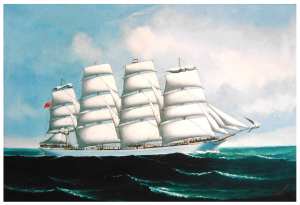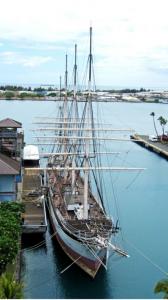The ship will be scuttled without action
HONOLULU, HAWAII, USA, June 23, 2021 /EINPresswire.com/ -- Built in 1878, the Falls of Clyde is the last of eight iron-clad cargo ships built on the River Clyde at Port Glasgow, Scotland. It took a special act of the U.S. House of Representatives for her to be allowed to work in the United States and her former legacy owners, among others, are Matson Shipping, Chevron, Marathon, B.P. and Exxon.Her seven sister ships were either lost at sea or to action during World War I and World W ar II. Now, the Falls of Clyde, one of the last remaining sail-driven oil tankers in the world and which was designated a U.S. National Historic Landmark in 1989, is facing a similar fate.
The Hawaii Department of Transportation plans to scuttle the ship, which is currently moored in Honolulu.
But not if Falls of Clyde (FOC) International has anything to do with it.
The FOC is sounding the alarm about the fate of the ship and is calling on all interested parties to contact government and other officials to ask the Hawaii Department of Transportation to rescind the RFP for Disposal and give the FOC the time it needs to reclaim the Falls of Clyde.
“Once she is scuttled, this iconic piece of our maritime heritage is lost forever from future generations. We are in desperate need of your support, by speaking out and with financial contributions. We need to get the ship lifted to the River Clyde in Scotland where she will be restored,” said a spokesperson for the FOC, which was formed in 2016 and has a worldwide membership.
“This is a call to action to the people of Hawaii, to all Americans and the people of Scotland, and to all who care about supporting their maritime heritage, as well as rising sea levels and global marine pollution, to join us and support the Falls of Clyde rescue effort,” the spokesperson added.
The FOC has an innovative proposal for the salvage and repatriation of the Falls of Clyde that well-positions the rescue from environmental, harbor safety and financial standpoints. The FOC’s plan calls for a submersible lift ship to float the Falls of Clyde on to its deck and then lash her down for the voyage back to Port Glasgow.
Leaders of the FOC don’t want the Falls of Clyde to become another ‘static’ museum. The FOC team has crafted plans for the ship’s teaching program after its refurbishment, which encompass the environment, climate change, technology, social causes and heritage.
In order to sustain her future, FOC leaders looked for operations where the ship could earn a living and support herself. After extensive research of other vessels of similar stature and age, the FOC began working with and building relationships with various tech companies and global maritime organizations to help with its rescue efforts.
The FOC blueprint calls for a full restoration of the Falls of Clyde. She will be rebuilt as a fully rigged sailing ship once again, with special attention paid to its impact on the environment. The Falls of Clyde will be fitted with a 100 percent clean emission propulsion and energy storage. This effort is in accordance with the Biden Administration’s support for decarbonization of the maritime industry and with the United Nations’ sustainability goals.
“The Falls of Clyde will become a symbol of Scotland's lead in the world of new ecotechnologies, alternative propulsion and hydrogen/electric power systems,” the FOC spokesperson said.
The Falls of Clyde will also play a big part in clearing the Pacific Ocean of discarded ghost nets from fishing; will offer education at sea, with opportunities for students to sail onboard and learn how to sail a tall ship; and hands-on education on the climate and marine environment.
“We are passionate in ensuring that everyone can get a chance to thrive and work together to
make the world a better place,” the spokesperson said.
Plans also call for the Falls of Clyde to carry ethically produced local products.
Military from the United States and the Royal Navy will be offered the opportunity to learn traditional sailing skills on the Falls of Clyde.
British engineering company Marine & Industrial Transmissions (MIT) is supporting the plan by developing a sustainable diesel power solution for the project. Its expert team of alternative power engineers have been working on a range of solutions to deliver emission-free sailing, including wind, solar and battery storage.
Their initial plans are to use a combination of industry-leading marine thrusters, driven by
either electric or hydrogen power, manufactured by Veth Propulsion, which creates simplistic and intensely engineered solutions. “Over the last five decades, Veth Propulsion has developed a range of robust and sustainable emission-free power alternatives suitable for a variety of vessels due to the flexibility of their models,” said an MIT spokesperson.
The ship was named after the Falls of Clyde, a group of waterfalls on the River Clyde, and built to the highest standard for general worldwide trade.
Her storied history began with a maiden voyage that took her to Karachi, now in Pakistan, and her first six years were spent engaged in the India trade. She then became a tramp, pursuing general cargo such as lumber, jute, cement and wheat from ports in Australia, California, India, New Zealand and the British Isles.
After 21 years as a British merchant ship, the Falls of Clyde was purchased for $25,000 by Captain William Matson of the Matson Navigation Company, taken to Honolulu in 1899 and registered under the Hawaiian flag. When the Republic of Hawaii was annexed by the United States in 1900, it took a special act of the United States Congress to secure the foreign-built ship the right to sail as an American flag vessel.
From 1899 to 1907, she made more than 60 voyages between Hilo, Hawaii and San Francisco, California, carrying general merchandise west, sugar to the east, and passengers both ways. She developed a reputation as a handy, fast and commodious vessel, averaging 17 days each way on her voyages.
In 1973, the Falls of Clyde was entered into the National Register of Historic Places.
“We have the support of the entire maritime heritage community and she is welcomed back in Scotland,” the FOC spokesperson said. “We must prevent this substantial part of Hawaii’s and Scotland’s heritage from being discarded by deliberately sinking her at sea.”
Restoration of the Falls of Clyde is estimated at $20 million and is expected to take three years.
For more information about the Falls of Clyde, to make a donation or to learn about volunteer opportunities, visit foci.scot. The continuing adventures of the Falls of Clyde can also be followed on Friends of the Falls of Clyde Facebook page and on Twitter at @FallsofClydeHI.
Falls of Clyde Mission Statement
Our mission statement is simple: we will use heritage to educate future generations, in
clean emission tech, the environment – driving change through innovation. We aim to
share our heritage, unlock individual potential and build new lives through opportunity,
education and conservation.
###
Media Relations
PR Services
email us here















